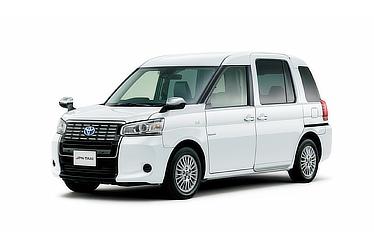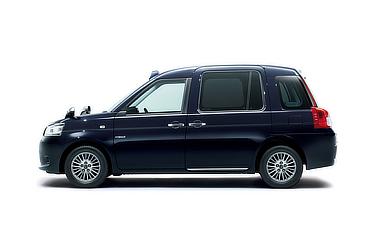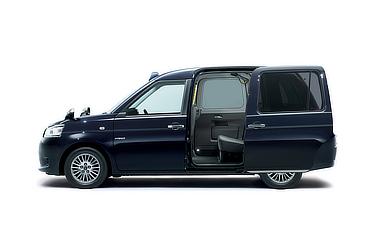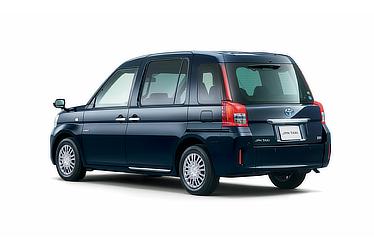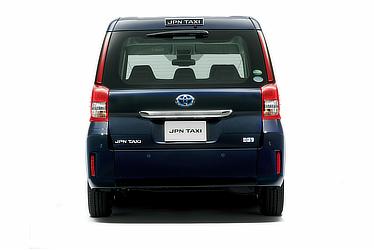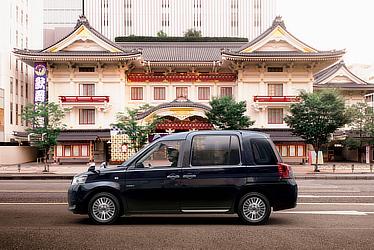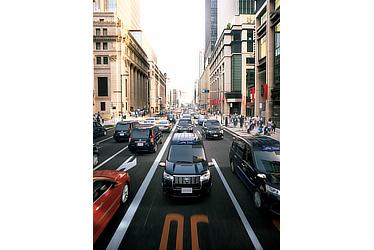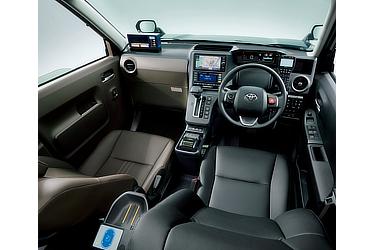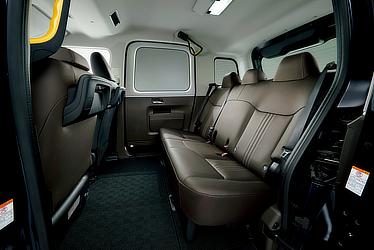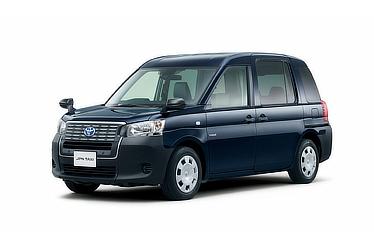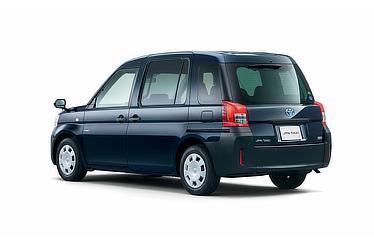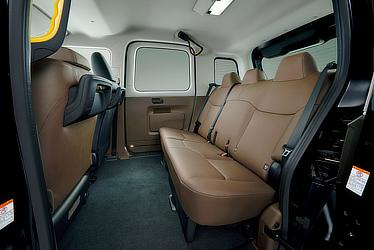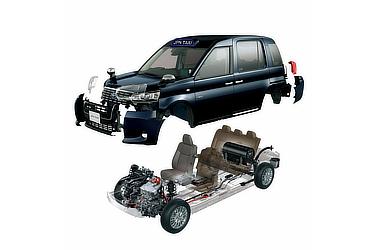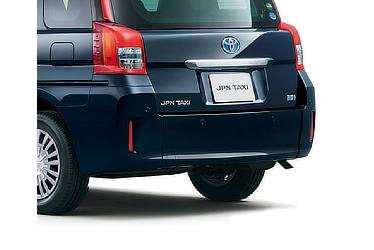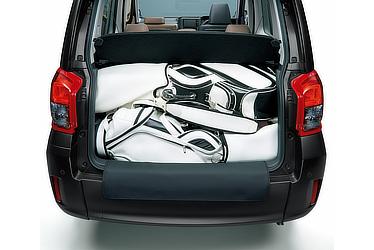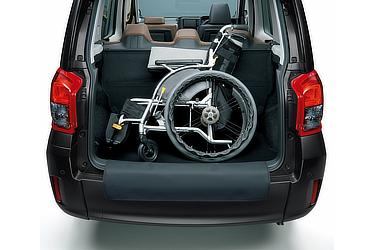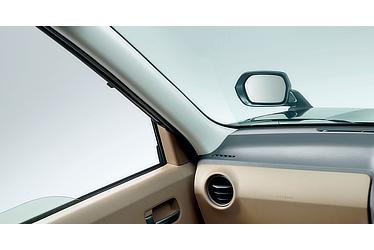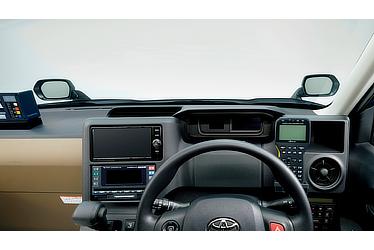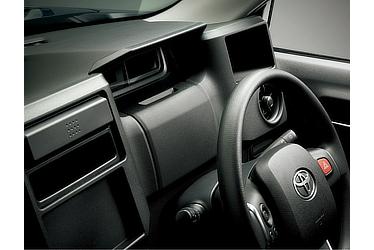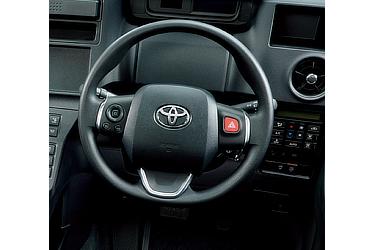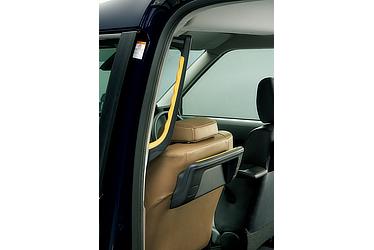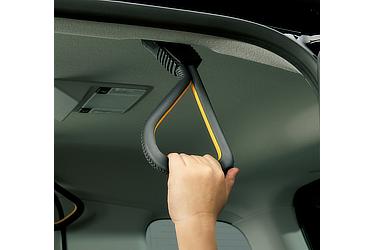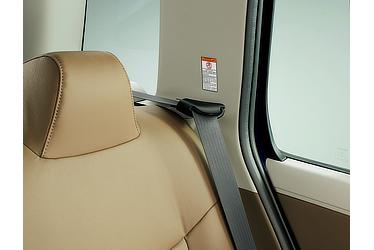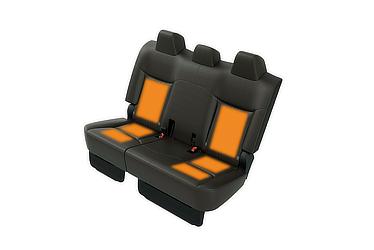Oct. 23, 2017
Toyota Rolls Out New Model for "JPN Taxi"
Introducing a people-friendly, next-generation taxi that embodies the spirit of Japanese hospitality
- People-friendly universal design1, including low, flat floor and wide-opening rear sliding door
- Designed to harmonize with urban life but instantly recognizable as a taxi at a glance, with a deep indigo body
- Equipped with reinforced safety equipment, including Toyota Safety Sense C and six SRS airbags2
Toyota City, Japan, October 23, 2017―Toyota Motor Corporation (Toyota) launched a new taxi vehicle, the "JPN Taxi." The new model became available today at Toyota and Toyopet dealers nationwide.
The JPN Taxi embodies the spirit of Japanese hospitality. It was developed to provide usability and comfort to a wide range of people, including children, seniors, wheelchair users, and visitors to Japan from abroad. Toyota aims to change Japan's landscape, develop barrier-free cities, and transform Japan into a tourist-oriented country by promoting the widespread use of its JPN Taxis.
The new model showcases a people-friendly, universal design that provides usability and comfort to a wide range of people through continual innovations and improvements, from grab handles to the overall vehicle structure. Design features include a low, flat floor, making it easy for customers to ingress and egress from the taxi, a wide-opening, power rear sliding door (left side only) and space to accommodate wheelchair users3.
In addition, the taxi is designed to beautifully complement the cityscape while at the same time being easily recognizable as a taxi. This is achieved in part due to the car's styling, which aims to transcend trends and serve as a timeless classic model, as well as the body's deep indigo (koiai) tone, a traditional color that has long been a symbol of Japan.
Furthermore, this model offers the driver an optimal range of vision, in part through innovations to the position and shape of the pillars and the use of fender mirrors. As a design priority for this taxi model, functionality was improved by positioning the dashboard instruments and other devices in the taxi to allow easy access, including the placement of the GPS system and taxi meter in a spot that is easy for customers to see.
Environmental performance and power performance were both taken to new levels. By employing a newly developed liquefied petroleum gas (LPG) hybrid system, the new model offers 19.4 km/L4 fuel economy and sharply reduced CO2 emissions. Enhancements were made to safety equipment, including adding the Toyota Safety Sense C package and six SRS airbags as standard features.
Toyota began its venture into the taxi industry in Japan in 1936 with the introduction of the Toyota Model AA. In 1953, Toyota released the Toyopet Super RH model and other vehicles, which have become fixtures helping transport many people over the years. Toyota taxis have and will continue to travel greater distances than the average vehicle and be used in the toughest road conditions. This could be considered the starting point for automobiles that pursue a vision of ideal automotive development.
Toyota looks forward to exhibiting its JPN Taxi at the 45th Tokyo Motor Show 2017, and also plans to use the taxi to greet visitors from around the world in 2020, when Tokyo hosts the Olympic and Paralympic Games.
-

- Takumi
-

- Takumi
1,000 units
Higashi-Fuji Plant, Toyota Motor East Japan Inc.
| Grade | LPG-hybrid system | Driveline | Price*1 (Japanese Yen) |
|---|---|---|---|
| Nagomi | THS II*2 with reduction gear (1NZ-FXP 1.5-liter) |
Front-wheel-drive | 3,277,800 |
| Takumi | 3,499,200 |
NOTEThe indigo blue limited edition model is the same price (an indigo blue car featuring advertising of the Tokyo 2020 Olympic and Paralympic Games logo on the rear door).
*1Includes consumption tax and does not include recycling fees. Separate pricing applies for Hokkaido and Okinawa.
*2THS IITOYOTA Hybrid System II
-
People-friendly, universal design that blends in with the cityscape but at the same time is easily recognizable as a taxi
Exterior designA next-generation taxi designed to be recognizable by customers at a glance and to endure for decades, transcending trends.Side
- Spacious design featuring a wide-opening rear sliding door highlighting the passenger area
- Large windows enable customers to enjoy a view of the landscape
Front- The sturdy outline that supports the large cabin is an expression of sophistication and safety.
- A modern design that carries on the heritage of the Toyota Crown ("Crown Sedan," "Crown Comfort," and "Comfort") with a horizontal lattice motif radiator grille that emphasizes surface beauty
- The standard-grade model, "Nagomi," uses halogen headlights. It also has an affable, distinct look owing to its simple front-end structure with turn signal lights positioned on the corners. The luxury model, "Takumi," is an expression of high quality and high performance, as demonstrated by incorporating the Bi-Beam LED headlights, front position lights, and turn signal lights into a single unit.
- Equipped with remote-controlled power fender mirrors to easily ascertain the width of the chassis at a mere glance
Rear- Imparts an aura of dignity suitable for use in formal situations, like a sedan, with a sturdy, notch-shaped rear door
- The rear combination taillights have a 3D structure and wrap around the sides and surface. The surrounding parts run consecutive with the break lines giving it a refreshingly modern appearance. The luxury grade Takumi exudes a sense of high quality attributable to the vertical rear lights on its D pillars.
-

- Front view (Takumi)
-

- Rear view (Takumi)

Side view (Takumi)
The photo above is an example of where the taxi roof sign would appear on the front and rear of the roof (display and shape vary by taxi company).
- A wide-opening rear sliding door (width: 720 mm, height: 1,300 mm), low, flat floor (floor height: 320 mm), and conveniently placed grab handles5 makes it easier for customers to ingress and egress from the taxi.
- Designed with an optimal point of ingress and egress for wheelchair users from the wide-opening rear sliding door and a seat for caregivers to sit next to the wheelchair user
- The people-friendly cabin package includes large windows, a spacious front and rear seat area (1,065 mm), a head clearance in the back seat of 230 mm, and the use of the entire cabin width to provide ample shoulder room.
- Quality riding comfort owing to plushly padded, flat seats and an optimized framework allows passengers to move sideways more easily.
- Seat belts are easy to reach and pull out thanks to the seat belt extender. Additionally, seat belts in the back seat are lit with LED lighting to make them easy to identify even at night (LED lighting equipped only on the left and right seats)
- Offers exceptional quietness, including the optimal use of sound absorption and soundproofing materials, plus high-quality soundproof glass
- The air conditioning vents in front of the driver's seat and passenger seat feature a Nanoe6 air purifier
- The luxury grade Takumi comes with a ceiling air circulator and air vents in the back seat that efficiently distribute cool air from the air conditioner. There is a lever so that customers can adjust the air flow themselves. There is also a back seat heating system that customers can operate themselves.
- The various instruments are grouped by function making them easy for the driver to operate. Specifically, the car dispatch system, air conditioning, and other instruments operated by the driver are positioned on the driver's right side while the navigation (GPS) system, taxi meter, and other instruments are placed in view of passengers. The hazard switch, which is frequently used, is located on the right side of the steering wheel.
- The storage space is located in an area barely visible to passengers, and additional devices can be stored in a space behind the steering wheel. Owing to this ample storage space and optimal positioning of storage areas, the vehicle is well-suited for professional use.
- The 401-liter (VDA standard) luggage compartment offers ample capacity with enough space to fit two large suitcases horizontally7 and four golf bags7. The rear space necessary for opening and closing the back door is 560 mm (room for one suitcase).
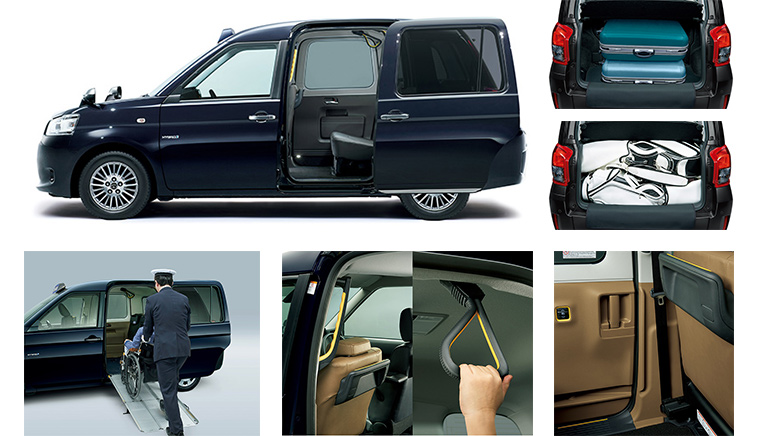
-
High environmental performance and fuel economy owing to a newly developed LPG-hybrid system
This next-generation taxi is gentle on the environment and contributes to low running costs thanks to its 19.4 km/L fuel economy performance and its ability to run on LPG fuel, since it is equipped with a hybrid system (THS II) (which was developed over many years).
-
Taxi designed with durability and economy in mind
- The front suspension adopts the MacPherson strut-type coil spring while the rear suspension employs a trailing link axle-type coil spring (three links), both designed for use in a taxi and to contribute to durability.
- The side portions of the front and rear 3-part bumper are replaceable. Only the outer lenses of the lights are replaceable. In addition, the superior maintainability of the engine, including the use of a no-maintenance power water pump in the auxiliary belt system, contributes to lower repair costs.
-
Advanced safety performance
- There is a wide lineup of active safety systems available. Toyota Safety Sense C (TSS-C), a collision avoidance support package, comes standard for all grades. Meanwhile, the Intelligent Clearance Sonar, which detects obstacles and helps prevent or mitigate collisions caused by rapid acceleration after pedal misapplication, comes as an option (parking support brake system).
- This vehicle, as well as other TSS-C-equipped vehicles, are adherent to the Safety Support Car recommendation8 of the Ministry of Economy, Trade and Industry (METI) and the Ministry of Land, Infrastructure, Transport and Tourism (MLIT) of Japan, classified in the "Basic+" Safety Support Car S (Sapo Car S) category, and recommended for older drivers.
- Another standard feature is the six SRS airbags for safety and security in the event of a collision.
1Universal design is the practice of making products that anyone, including seniors, wheelchair users, pregnant women, and people traveling with children, can easily use. The JPN Taxi conforms to the certification guidelines (Level 1) for the Japanese government-approved standard specifications for a universal design taxi.
2SRS airbags (driver/front passenger seat), SRS side airbags (driver/front passenger seat), and SRS curtain shield airbags (front and back seats)
3In certain cases, passengers may be prevented from boarding the taxi depending on the shape of their wheelchair or rolling performance. In accordance with transportation rules, individuals may be asked to move to a safe location to board in the event that safety cannot be ensured. Visit the following site for details: http://toyota.jp/jpntaxi/
4Under the Japanese Ministry of Land, Infrastructure, Transport and Tourism's JC08 test cycle.
5Grab handles for ingressing and egressing (back seat, left side only), seat back assist board, grab handle (strap type), and child grip (back seat, left side only)
6Nanoe and the Nanoe logo are trademarks of Panasonic Corporation.
7Suitcase size: size 77 (839 mm × 603 mm × 295 mm). Golf bag size: 9.5 inches. (depending on size and shape)
8The Safety Support Car (Sapo Car) category includes vehicles equipped with automated braking systems. The Safety Support Car S (Sapo Car S) category includes vehicles that are additionally equipped with a pedal misapplication prevention system and is recommended for all drivers, including the elderly. The Sapo Car S category is composed of 3 sub-categories (varying by automated braking features), one of which is the "Basic+" sub-category. The "Basic+" sub-category includes automated braking system (vehicle collision prevention) and pedal misapplication prevention system.
JPN Taxi is scheduled to be exhibited at the Tokyo Motor Show and will also be showcased in a planned excursion tour around the Tokyo Bay area for nine days from October 28 (Saturday) to November 5 (Sunday), departing from both Tokyo Big Sight and Mega Web, Toyota's vehicle experience facility in Tokyo's Koto Ward.
- Tokyo Motor Show 2017 exclusive website
- http://newsroom.toyota.co.jp/en/tms2017/
- JPN Taxi exclusive website
- http://newsroom.toyota.co.jp/en/jpntaxi/
- Link to the "JPN Taxi" webpage (Japanese only)
- http://toyota.jp/jpntaxi/
Downloads (Images)
- Photo gallery of the Toyota booth at the Tokyo Motor Show 2017
- http://newsroom.toyota.co.jp/en/tms2017/gallery/






